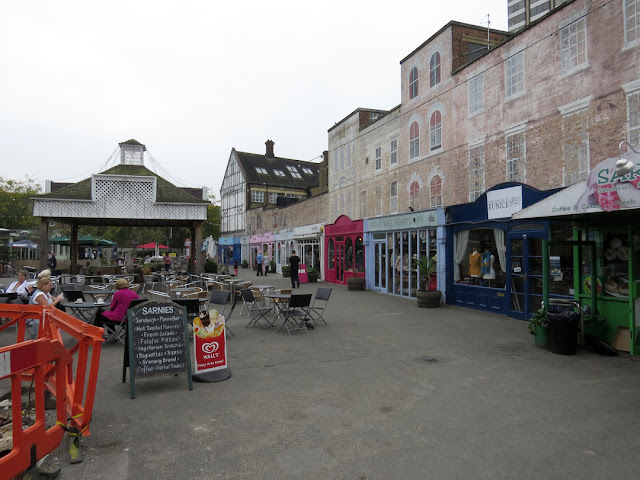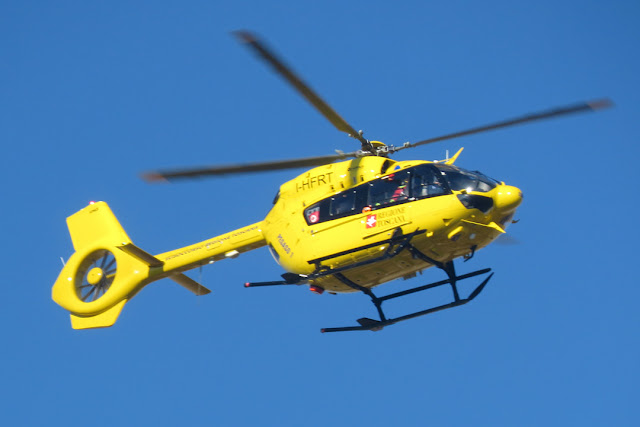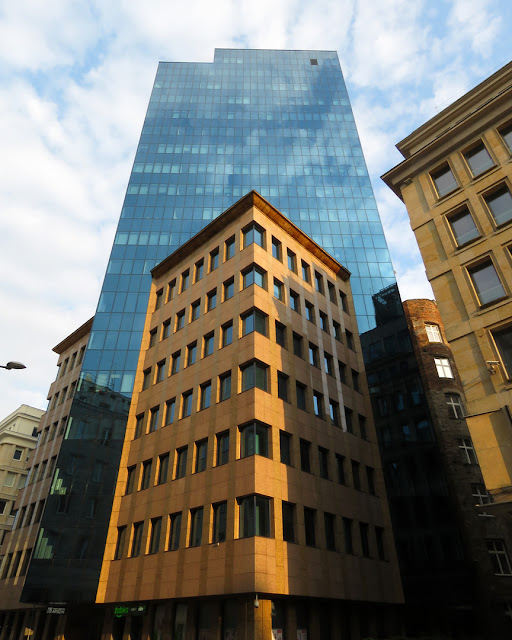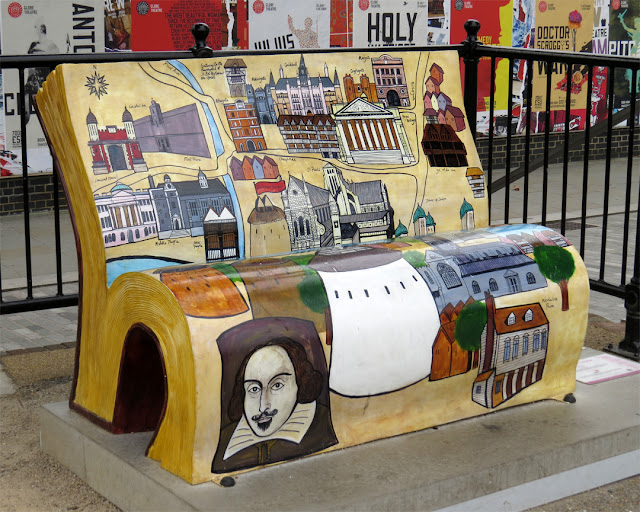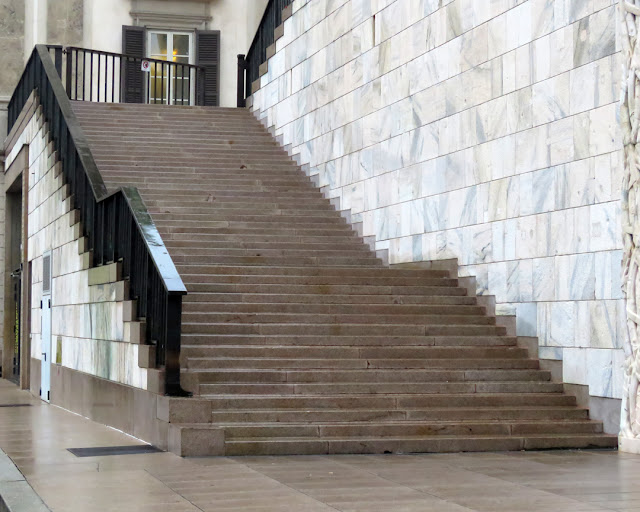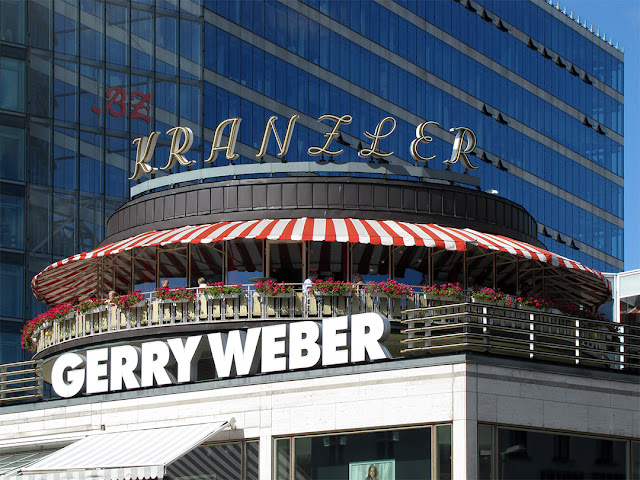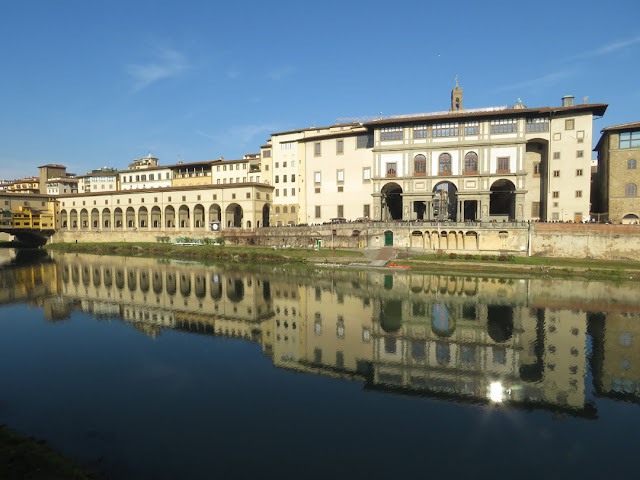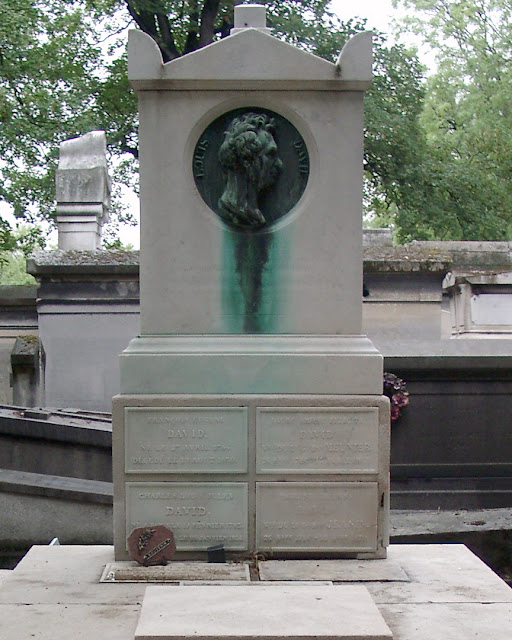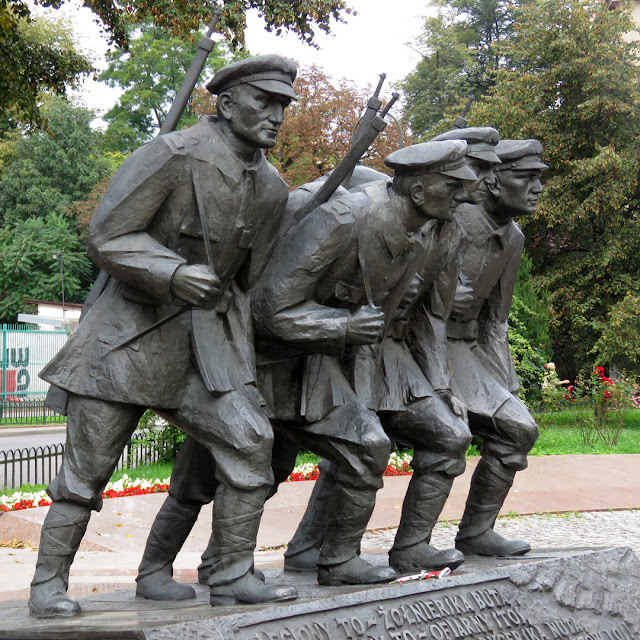Sunday, March 31, 2019
Warrior with Shield
“Warrior with Shield” by Henry Moore, 1972
Basilica of Santa Croce
Piazza di Santa Croce
Florence, January 2019
“However, the strange thing is that this sculpture, one of six copies of the ‘Warrior with Shield’, was not one of them. This 1972 version of the ‘Warrior with Shield’, subject came to Santa Croce in 1987 on loan by the British Institute after having been donated to the Institute by Moore’s widow Irene. The sculpture was first on display in a rather hidden inner garden at Palazzo Vecchio, which bothered some who thought it deserved more visibility. Hence, it was moved to its current location at Santa Croce.” (Henry Moore ‘s ‘Warrior with Shield’, The Basilica of Santa Croce)
Saturday, March 30, 2019
Friday, March 29, 2019
Eugène Scribe
Grave of Eugène Scribe (1791-1861)
Cimetière du Père-Lachaise, (Père Lachaise Cemetery)
Quartier du Père-Lachaise, 20th arrondissement
Paris, July 2006
“Augustin Eugène Scribe (24 December 1791 – 20 February 1861) was a French dramatist and librettist. He is known for the perfection of the so-called ‘well-made play’ (pièce bien faite), a mainstay of popular theatre for over 100 years, and as the librettist of many of the most successful grand operas.” (Eugène Scribe, Wikipedia)
Thursday, March 28, 2019
Wednesday, March 27, 2019
Sea Towers
Sea Towers, 2009
Antoniego Hryniewickiego
Gdynia, September 2018
“The Sea Towers is a mixed-use skyscraper complex in Gdynia, Poland. Construction commenced on 10 May 2006 and was completed on 28 February 2009. At 143.6 meters, Sea Towers is the 12th tallest building in Poland and the second tallest residential building in the country.” (Sea Towers, Wikipedia)
Tuesday, March 26, 2019
Monday, March 25, 2019
Airbus Helicopters H145
Airbus Helicopters H145
Piazzale Michelangelo
Florence, December 2018
“The Eurocopter EC145 (now Airbus Helicopters H145) is a twin-engine light utility helicopter developed and manufactured by Eurocopter, which was rebranded as Airbus Helicopters in 2014. Originally referred to as the BK 117 C2, the EC145 is based upon the MBB/Kawasaki BK 117 C1, which became a part of the combined Eurocopter line-up in 1992 with the merger of Messerschmitt-Bölkow-Blohm's helicopter division of Daimler-Benz and the helicopter division of Aérospatiale-Matra to form Eurocopter. The EC145 is a twin-engine aircraft and can carry up to nine passengers along with two crew, depending on customer configuration. The helicopter is marketed for passenger transport, corporate transport, emergency medical services (EMS), search and rescue, parapublic and utility roles. In 2015, the EC145 was rebranded as the H145 by Airbus Helicopters. Military variants of the helicopter have also been produced under various designations, such as H145M or UH-72, and have been used for training, logistics, medical evacuation, reconnaissance, light attack, and troop-transport operations.” (Eurocopter EC145, Wikipedia)
Sunday, March 24, 2019
Saturday, March 23, 2019
Friday, March 22, 2019
Monument to Giuseppe Parini
Monument to Giuseppe Parini by Gaetano Monti, 1838
Palazzo Brera
Via Brera
Milan, November 2016
“Giuseppe Parini (23 May 1729 – 15 August 1799) was an Italian enlightenment satirist and poet of the neoclassic period. Parini (originally spelled Parino) was born in Bosisio (later renamed Bosisio Parini in his honour) in Brianza, Lombardy from a poor family. His father, who was a petty silk trader, sent him to Milan under the care of his great aunt: there he studied under the Barnabites in the Academy Arcimboldi, sustaining himself in the meantime by copying manuscripts. In 1741 his great aunt left him a monthly payment, on the condition that he entered the priesthood. Parini was thus ordained, although his religious studies were not profitable because of his need to work in a lawyer's office during his free time and his intolerance of the old-fashioned teaching methods used.” (Giuseppe Parini, Wikipedia)
Thursday, March 21, 2019
Tauron Arena Kraków
Tauron Arena Kraków
Stanisława Lema
Kraków, September 2018
“Tauron Arena Kraków is an indoor arena located in Kraków, Poland. It has a seating capacity of 15,030 for sporting events. It hosted the 2014 FIVB Volleyball Men's World Championship tournament, 2016 European League of Legends Championship Finals and 2015 IIHF Ice Hockey World Championship Division I. Tauron Arena Kraków is the largest and one of most modern entertainment and sports venues in Poland. It allows to host a variety of sports events, including badminton, boxing, curling, acrobatic and artistic gymnastics, indoor football, hockey, basketball, track and field, figure skating, volleyball, handball, martial arts, extreme sports, tennis, table tennis, equestrian competitions and sports dancing competitions. The facility area has 61,434 m2, with maximum area of the arena court of 4 546 m2. The average capacity is 18,000 for concerts, and 15,000 for sport events, with maximum number of spectators being 22,000. The Arena boasts Poland's largest LED media façade, with a total surface of 5,200 m2 of LED strip lighting, wrapping around the stadium, and one of Europe's largest LED screens, measuring over 540 m2.” (Tauron Arena Kraków, Wikipedia)
Wednesday, March 20, 2019
Elefantentor
Elefantentor (Elephant Gate)
Zoologischer Garten Berlin (Berlin Zoological Garden)
Hardenbergplatz
Berlin, September 2011
“The Berlin Zoological Garden (German: Zoologischer Garten Berlin) is the oldest surviving and best-known zoo in Germany. Opened in 1844, it covers 35 hectares (86.5 acres) and is located in Berlin's Tiergarten. With about 1,380 different species and over 20,200 animals, the zoo presents one of the most comprehensive collections of species in the world. The zoo and its aquarium had more than 3.5 million visitors in 2017. It is the most-visited zoo in Europe and one of the most popular worldwide. Regular animal feedings are among its most famous attractions. Globally known animals like Knut, the polar bear, and Bao Bao, the giant panda have contributed to the zoo's public image. The zoo collaborates with many universities, research institutes, and other zoos around the world. It maintains and promotes European breeding programmes, helps safeguard several endangered species, and participates in several species reintroduction programs.” (Berlin Zoo, Wikipedia)
Tuesday, March 19, 2019
Mentana and Monterotondo
Monumento ai Caduti di Mentana e Monterotondo
(Monument to the Fallen of Mentana and Monterotondo)
by Oreste Calzolari, 1902
Piazza Mentana
Florence, January 2019
“In the first hours of November 3, the Papal troops, under general Hermann Kanzler, and the French expeditionary corps, under general Balthazar de Polhès, moved from Rome to attack Garibaldi's army along the Via Nomentana. The Allies were well trained and organized, and the French troops were armed with the new Chassepot rifle; Garibaldi's volunteers were less well organized, and nearly without any artillery or cavalry, apart a small squadron led by Garibaldi's son, Ricciotti. The Papal vanguards met Garibaldi's volunteers about 1.5 km south of the village Mentana, midway from Rome to Monterotondo. The three battalions defending the position were quickly dislodged. However, Garibaldi's resistance stiffened in the fortified village, and repeated Papal attacks were all pushed back until nightfall. The situation changed when three companies of Zouaves occupied the road from Mentana and Monterotondo. Garibaldi intervened in person, but could not prevent his troops being routed. The survivors entrenched in the castle of Mentana; some surrendered the following morning, and others fled to Monterotondo. On November 4 Garibaldi retreated to the Kingdom of Italy with 5,100 men. In Mentana, the monument Ara dei Caduti (Altar of the Fallen) is built over the mass grave of the Italian patriots who died in the battle. Subsequently, a French garrison remained in Civitavecchia until August 1870, when it was recalled following the outbreak of the Franco-Prussian War. Rome was captured by the Italian Army on September 20, 1870, finally giving Italy possession of its capital.” (Battle of Mentana, Wikipedia)
Monday, March 18, 2019
Fontanna Neptuna
Fontanna Neptuna (Neptune's Fountain)
Długi Targ
Gdańsk, September 2018
“Neptune's Fountain (German: Neptunbrunnen) is a historic fountain in Gdańsk (Danzig), a mannerist-rococo masterpiece, and one of the most distinctive landmarks of the city. The fountain is located at the Długi Targ, in front of the entrance to the Artus Court. It was constructed in the early 17th century. Kashubians use a nickname Krësztof for the sculpture. In 1549 a now unknown well was located by the entrance of Artus Court, which may have had metal decorative pieces. The well was located slightly closer to the Motława. The local authorities of Danzig, together with Mayor Bartholomäus Schachmann wanted to raise a more notable monument. The first mason to receive an offer to complete the project was Jakob Kordes from Lübeck, but for unknown reasons, his plan was not accepted. The new fountain was to be constructed at the centre of the facade of the Artus Court, from the Green Gate the fountain would be seen with the Main town hall in the background, with the turn to the Long Lane. Neptune - the god of the sea - was to be placed facing the townhouses, which were the residence of the Polish kings,[citation needed] while at their stay in Danzig, the mythological god was to have his head bow down to them. The fountain was to have underground pumps connecting the fountain to the Potok Siedlecki by Sienny Market; however, the pressure was too low.” (Neptune's Fountain, Wikipedia)
Sunday, March 17, 2019
Vincenzo Bellini
Grave of Vincenzo Bellini (1801-1835)
Cimetière du Père-Lachaise, (Père Lachaise Cemetery)
Quartier du Père-Lachaise, 20th arrondissement
Paris, July 2006
“Vincenzo Salvatore Carmelo Francesco Bellini (3 November 1801 – 23 September 1835) was an Italian opera composer, who was known for his long-flowing melodic lines for which he was named ‘the Swan of Catania’. Many years later, in 1898, Giuseppe Verdi praised the broad curves of Bellini's melody: ‘there are extremely long melodies as no-one else had ever made before’. A large amount of what is known about Bellini's life and his activities comes from surviving letters—except for a short period—which were written over his lifetime to his friend Francesco Florimo, whom he had met as a fellow student in Naples and with whom he maintained a lifelong friendship. Other sources of information come from correspondence saved by other friends and business acquaintances.” (Vincenzo Bellini, Wikipedia)
Saturday, March 16, 2019
Arengario Staircase
Staircase, Palazzo dell'Arengario
Piazza del Duomo
Milan, November 2016
“The Palazzo dell'Arengario is a Fascist-era complex of two symmetrical buildings in Piazza del Duomo, the central piazza of Milan, Italy. It was completed in the 1950s and currently houses the Museo del Novecento, a museum dedicated to 20th-century art. The word ‘arengario’ refers to its original function as a local government seat in the Fascist period. The Arengario was designed by Piero Portaluppi, Giovanni Muzio, Pier Giulio Magistretti e Enrico Agostino Griffini. Construction began in 1936, but experienced several delays and suffered from the World War II bombings; it was eventually completed in 1956. The façade is decorated with reliefs by Arturo Martini.” (Palazzo dell'Arengario, Wikipedia)
Friday, March 15, 2019
Mermaid of Powiśle
Mermaid of Powiśle by Ludwika Nitschowa, 1939
With the Świętokrzyski Bridge in background
Ulica Wybrzeże Kościuszkowskie
Warsaw, September 2018
“This statue, made of gunmetal, was erected in April 1939 in Powiśle near the Vistula river. The sculpture is by Ludwika Nitschowa and posed by poet Krystyna Krahelska. In autumn of 2006, a silver plaque of the Virtuti Militari was added to the monument for General Sikorski who was awarded it in recognition of his defense of Warsaw in September 1939." (Mermaid of Warsaw, Wikipedia)
Thursday, March 14, 2019
Neues Kranzler-Eck
Neues Kranzler-Eck
Kurfürstendamm
Berlin, September 2011
“In 1932, the Café Kranzler branch on Kurfuerstendamm had opened under the name of Restaurant and Konditorei Kranzler (Restaurant and Patisserie Kranzler), operated by Kempinski Hotels. In 1945, during the Battle of Berlin it, too, was completely destroyed, and the café did not open its doors again until 1951, long after Berlin’s division. At the time of the reopening, the café was housed in a one-story structure (ground floor plus an upper story), which was replaced in 1957/1958 with a two-story building (ground floor plus two upper stories) and a rotunda at the top. The rotunda had a red and white striped awning, which became an easily recognizable landmark. After the second re-opening in 1958, Café Kranzler quickly became a magnet for tourists and socialites and grew into something akin to an institution in West Berlin. It was the Kranzler that I knew and loved in the 1960s. Despite being spread over three floors, until the end of 1999, its guests preferred to sit in the sidewalk and watch the world go by. In 2000, in the wake of the fall of the Berlin Wall, all that changed. Café Kranzler had to close its doors for the third time because the city implemented massive redevelopment plans for the area. In 2001, it re-opened as Neues Kranzler Eck, part of a shopping center and operated by the clothier Gerry Weber. The fashion designer occupied the ground and upper floors, and Café Kranzler was limited to the use of the rotunda. In fact, the café became something of an afterthought. It could only be accessed via a staircase inside the clothing store or via an elevator at the end of a long hall. Gone were the days as well of enjoying a coffee in the sidewalk while people-watching. The sidewalk was now off limits to Kranzler guests. It was a café during the day and a bar at night.” (Berlin’s Café Kranzler in Name Only, Walled in Berlin)
Wednesday, March 13, 2019
Corridoio Vasariano
Vasari Corridor and Uffizi Gallery
Lungarno degli Archibusieri
Florence, January 2019
“The Vasari Corridor (Corridoio Vasariano) is an elevated enclosed passageway in Florence, central Italy, which connects the Palazzo Vecchio with the Palazzo Pitti. Beginning on the south side of the Palazzo Vecchio, it then joins the Uffizi Gallery and leaves on its south side, crossing the Lungarno dei Archibusieri and then following the north bank of the River Arnountil it crosses the river at Ponte Vecchio. At the time of construction, the corridor had to be built around the Torre dei Mannelli, using brackets, because the owners of the tower refused to alter it. The corridor covers up part of the façade of the Church of Santa Felicita. The corridor then snakes its way over rows of houses in the Oltrarno district, becoming narrower, to finally join the Palazzo Pitti. It was closed in 2016 for safety reasons. In 2019, the Uffizi Gallery announced that the corridor will re-open for tourists in 2021.” (Vasari Corridor, Wikipedia)
Tuesday, March 12, 2019
Arka Pana
Kościół Matki Bożej Królowej Polski (Arka Pana), 1977
Church of Our Lady Queen of Poland
ul. Obrońców Krzyża, Nowa Huta
Kraków, September 2018
“Built between 1967 and 1977, Nowa Huta’s first house of worship was designed by Wojciech Pietrzyk and was pieced together brick by brick by volunteer workers with no assistance from the communist authorities. The complete opposite of what Nowa Huta was meant to stand for, The Lord's Ark (Arka Pana) is a remarkable building, and a true symbol of the Polish belief in Catholicism. With no outside help it was down to the locals to mix cement with spades, and find the two million stones needed for the church’s facade. The first corner stone was laid in 1969 by Cardinal Karol Wojtyła, who would later assume fame as Pope John Paul II, but the discovery of a WWII ammunition dump delayed work, as some 5,000 mines and shells had to be carefully removed. Finally, on May 15th 1977, the church was consecrated. Built to resemble Noah’s Ark, with a 70 metre mast-shaped crucifix rising from the middle, the church houses an array of curious treasures, including a stone from the tomb of St. Peter in the Vatican, a tabernacle containing a fragment of rutile brought back from the moon by the crew of Apollo 11, and a controversial statue of Christ that shows him not on a cross, but about to fly to the heavens. If you think that's odd, check out the statue dedicated to Our Lady the Armoured – a half metre sculpture made from ten kilogrammes of shrapnel removed from Polish soldiers wounded at the Battle of Monte Cassino. In the early 1980s, the church became a focal point during anti-communist protests, not least for the shelter it afforded the locals from the militia. (The Lord's Ark, InYourPocket)
Monday, March 11, 2019
Shakespeare's Globe
Shakespeare's Globe
New Globe Walk
Southwark
London, September 2014
“Shakespeare's Globe is a reconstruction of the Globe Theatre, an Elizabethan playhouse for which William Shakespeare wrote his plays, in the London Borough of Southwark, on the south bank of the River Thames. The original theatre was built in 1599, destroyed by the fire in 1613, rebuilt in 1614, and then demolished in 1644. The modern Globe Theatre is an academic approximation based on available evidence of the 1599 and 1614 buildings. It is considered quite realistic, though modern safety requirements mean that it accommodates only 1,400 spectators compared to the original theatre's 3,000. Shakespeare's Globe was founded by the actor and director Sam Wanamaker, built about 230 metres (750 ft) from the site of the original theatre and opened to the public in 1997, with a production of Henry V. The site also includes the Sam Wanamaker Playhouse, an indoor theatre which opened in January 2014. This is a smaller, candle-lit space based on the indoor playhouses of Jacobean London. The Sackler Studios, an educational and rehearsal studio complex, is situated just around the corner from the main site. Michelle Terry currently serves as artistic director. She is the second actor-manager in charge of the organisation, following Mark Rylance, the founding artistic director.” (City of London School, Wikipedia)
Sunday, March 10, 2019
Monument to Cesare Beccaria
Monument to Cesare Beccaria by Pompeo Marchesi, 1837
Palazzo Brera
Via Brera
Milan, November 2016
“Cesare Bonesana di Beccaria, Marquis of Gualdrasco and Villareggio (15 March 1738 – 28 November 1794) was an Italian criminologist, jurist, philosopher, and politician, who is widely considered one of the greatest thinkers of the Age of Enlightenment. He is well remembered for his treatise On Crimes and Punishments (1764), which condemned torture and the death penalty, and was a founding work in the field of penology and the Classical School of criminology. Beccaria is considered the father of modern criminal law and the father of criminal justice. According to John Bessler, Beccaria's works had a profound influence on the Founding Fathers of the United States.” (Cesare Beccaria, Wikipedia)
Saturday, March 9, 2019
Oliwa Archcathedral
Archcathedral Basilica of The Holy Trinity
Biskupa Edmunda Nowickiego, Oliwa
Gdańsk, September 2018
“Gdańsk Oliwa Archcathedral is a church located in Gdańsk, Oliwa district; dedicated to The Holy Trinity, Blessed Virgin Mary and St Bernard. The archcathedral in Oliwa is a three-nave basilica with a transept and a multisided closed presbytery, finished with an ambulatory. The façade is flanked by two slender towers, 46-metres tall each with sharply-edged helmets. It is enlivened by a Baroque portal from 1688, as well as three windows of different sizes and three cartouches. The crossing of the naves is overlooked by a bell tower, a typical element of the Cistercian architecture. The cathedral is 17.7m high, 19m wide and 107m long (97.6m of the interior itself), which makes it the longest Cistercian church in the world. It holds works of art in Renaissance, Baroque, Rococo and Classical style of great artistic value.” (Oliwa Cathedral, Wikipedia)
Friday, March 8, 2019
Das Urteil des Paris
“Das Urteil des Paris” (The Judgment of Paris) by Markus Lüpertz, 2002
Kurfürstendamm / Joachimsthaler Straße
Berlin, September 2011
“Markus Lüpertz (born 25 April 1941) is a German painter, sculptor, graphic artist, and writer. He also publishes a magazine, and plays jazz piano. He is one of the best-known German contemporary artists. His subjects are characterized by suggestive power and archaic monumentality. Lüpertz insists on capturing the object of representation with an archetypal statement of his existence. His art work is associated to neo-expressionism. Known for his eccentricity, German press has stylized him as a ‘painter prince’.” (Markus Lüpertz, Wikipedia)
Thursday, March 7, 2019
“Vamba”
Funerary monument to “Vamba” by Libero Andreotti, 1923
Cimitero delle Porte Sante (The Sacred Doors Cemetery)
Florence, December 2018
“Luigi Bertelli (1858 - 1920), best known as Vamba, was an Italian author, illustrator and journalist. Born in Florence, having completed his studies Bertelli became a railway employer, working first in Rimini and later in Foggia. He later started collaborating with the Roman newspaper Capitan Fracassa and in 1884 he was officially employed as a journalist and caricaturist. He soon adopted the pseudonym ‘Vamba’, named after the clown of Walter Scott's Ivanhoe. After collaborating with several newspapers, in 1890 he founded and directed L'O di Giotto, a newspaper close to the radical political positions of Felice Cavallotti, and in 1901 he co-founded the regional newspaper Il Bruscolo. Best known as a children's author, in 1893 Vamba wrote his first pedagogical novel, Ciondolino, and in 1906 he founded and directed until 1911 the nonconformist children magazine Il giornalino della Domenica. Here, he released in sequential installments his best known novel, Il Giornalino di Gian Burrasca, the pedagogical and humorous story of a lively 9 year old. In the summer of 1920 he fell ill, dying on 27 November 1920. A funerary monument made by the sculptor Libero Andreotti was inaugurated in Florence on 14 January 1923.” (Vamba, Wikipedia)
Wednesday, March 6, 2019
Copernicus Science Centre
Planetarium The Heavens of Copernicus
Centrum Nauki Kopernik (Copernicus Science Centre)
Wybrzeże Kościuszkowskie
Warsaw, September 2018
“The Heavens of Copernicus is a modern planetarium where you can see more than just images of the starry sky and related films. The shows concern a variety of popular science issues, including from the field of astronomy, natural science and ethnography. The shows are displayed on a spherical screen surrounding the audience on all sides. Thanks to this solution, the audience experiences a feeling of immersion in the displayed world, which is strengthened by the high quality sound system deployed around the dome.” (Copernicus Science Centre, Wikipedia)
Tuesday, March 5, 2019
Jacques-Louis David
Grave of Jacques-Louis David (1748-1825)
Cimetière du Père-Lachaise, (Père Lachaise Cemetery)
Quartier du Père-Lachaise, 20th arrondissement
Paris, July 2006
“David's wife Marguerite Charlotte Pécoul is buried in Père Lachaise Cemetery in Paris, and a medaillon of David in relief has been mounted on her grave, where Joseph Marty claimed his heart is buried, oddly only mentioning that it was ‘near his wife's body’ but without mentioning her name.” (Grave of Jacques-Louis David, Wikipedia)
Monday, March 4, 2019
San Giuseppe
Church of San Giuseppe (Saint Joseph) by Francesco Maria Richini, 1630
Largo Victor de Sabata
Milan, November 2016
“San Giuseppe is a Baroque-style Roman Catholic church in Milan, region of Lombardy, Italy. Construction was begun in 1607 and completed in 1630. The architect was Francesco Maria Richini. The right side of the church overlooks Via Andegari, after a family with this name. It seems that the title of the street comes from the name of a family known as the ‘Andegardi’ or ‘undegardi’. The interior contains large altarpieces depicting the Marriage of St Joseph and the Virgin Mary by Melchiorre Gherardini; the Death of St Joseph by Giulio Cesare Procaccini; a Holy Family by Andrea Lanzani; and a St John the Baptist by Stefano Montalti.” (San Giuseppe, Wikipedia)
Sunday, March 3, 2019
The Four Legionnaires
The Four Legionnaires by Czesław Dźwigaj, 2008
Józefa Piłsudskiego
Kraków, September 2018
“Slightly further on you can find an extensive sculpture composed of a statue of Józef Piłsudski, the Four Legionnaires, and a flag post: a memorial for which Kraków had to wait for a long time. The idea of building a monument to Piłsudski in Kraków’s Błonia Common was already hatched in 1922, that is in the lifetime of the Marshal, yet it was never brought into effect. The monument by Czesław Dźwigaj was finally put up on the small square on the corner of Wenecja, Garncarska and Piłsudskiego streets, and unveiled on 10 November 2008, on the eve of the 90th anniversary of regaining independence.” (Marshal Józef Piłsudski Street, Kraków Travel)
Saturday, March 2, 2019
Kaiser-Brunnen
Drinking fountain Typ 1 or Kaiser-Brunnen
(named after the architect Siegfried Kaiser)
Kurfürstendamm
Berlin, September 2011
Friday, March 1, 2019
Neptune & Marzocco
Neptune by Bartolomeo Ammannati, 1565 (copy)
“Marzocco” by Donatello, 1420 (copy)
Piazza della Signoria
Florence, December 2018
“The Marzocco is the heraldic lion that is a symbol of Florence, and was apparently the first piece of public secular sculpture commissioned by the Republic of Florence, in the late 14th century. It stood at the heart of the city in the Piazza della Signoria at the end of the platform attached to the Palazzo Vecchio called the ringhiera, from which speakers traditionally harangued the crowd. This is now lost, having weathered with time to an unrecognizable mass of stone. The best known rendition is by Donatello, made in 1418–20. Donatello’s Marzocco was placed in the Piazza della Signoria in 1812, but in 1885 it was moved to the Bargello, having been replaced by the copy we see to this day.” (Marzocco, Wikipedia)
Subscribe to:
Posts (Atom)


